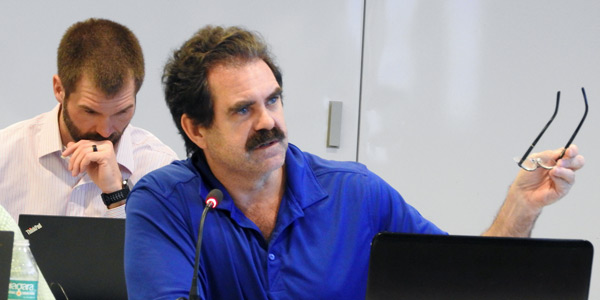By Rory D. Sweeney
A few months ago in an ISO not that far away…
Unrest grows along the PJM-NYISO border after the dismantling of the CON ED-PSEG WHEEL that for decades held sway over daily operations in the region. Expensive infrastructure replacements loom on the horizon, and stakeholders on both sides suspect the other of attempting to take advantage of the situation.
At the RAMAPO SUBSTATION, a phase angle regulator has failed, sparking a dispute between territorial transmission owners that threatens to reignite longstanding, deep-seated grudges.
As a last resort, a small group of delegates from both sides of the border have journeyed to an unassuming office complex on the outskirts of PHILADELPHIA to meet in person in the hope of averting chaos…
VALLEY FORGE, Pa. — If Friday’s joint PJM–NYISO meeting to discuss replacing a phase angle regulator (PAR) at Consolidated Edison’s Ramapo substation, near the New York-New Jersey border, had a “Star Wars”-like preamble crawling off into space, it would probably look something like that. Ok, maybe a bit less dramatic.
One of the substation’s two PARs failed in June, and Con Ed has hesitated to replace it until it receives certainty on how it will be paid for. That has been in question because the 1993 agreement signed by NYISO (then known as the New York Power Pool) and PJM transmission owners is in dispute.
The agreement covered just the original PARs at the facility, PJM transmission owners argue, neither of which remains in service. They say Con Ed’s decision in 2013 to replace the first failed PAR constituted a breach of the agreement, which requires the PJM transmission owners to be involved in the decision. Con Ed disagrees with that interpretation and believes the cost allocations under the contract — which would put PJM transmission owners who were a party to the agreement on the hook for 50% of the costs — remain in effect. However, stakeholders said that Con Ed’s reluctance to replace the failed equipment without knowing how it will be repaid doesn’t square with the company’s argument for why it replaced the first PAR after its failure in 2013, without consulting transmission owners.
“It seems like your own decision not to replace the PAR is in violation of your own interpretation of the agreement,” said Mark Younger of Hudson Energy Economics.
But before deciding on who should pay for it, some stakeholders are asking whether it needs to be replaced in the first place. In its current form, Calpine can’t support the project’s scope, company representative David “Scarp” Scarpignato said. “You really need to know what projects should be shared before you discuss sharing those costs,” he said. “The cost of paying for the PAR is not the big deal here. It’s that you’re potentially using the PAR to change the winners and losers here.”
He argued that the PAR helps alleviate congestion, which mutes the price signals on which generation companies like Calpine depend. “When you’re talking about using transmission to manage congestion rather than dispatching to address congestion, that is direct competition to generation,” he said.
Since the 1970s, operator and planners have operated under an agreement in which Con Ed wheels 1,000 MW of power through Public Service Electric and Gas’ transmission system in northern New Jersey into New York City. Con Ed announced last year that it no longer needs the service and would be canceling it as of May 1. Con Ed also canceled its membership in PJM and ended all commitments for cost allocation in the RTO, despite having been the reason for a substantial amount of now-unnecessary transmission upgrades. PJM stakeholders have taken issue with being forced to take on additional financial responsibility for maintaining infrastructure that’s no longer in use or being paid for by its intended beneficiary. (See NYISO Members OK End to Con Ed-PSEG Wheel.)
PSE&G’s Vilna Gaston asked if there had been an analysis regarding the benefits of replacing the PAR to determine if that’s even the best investment. “It seems like we’re proposing a solution before we do the investigation. This is putting the cart before the horse,” she said.
Despite their disagreements, stakeholders produced a list of objectives for a potential analysis, including ensuring the endorsed solution adheres to competitive market principles and that the cost allocation is aligned with who receives the benefits.
PARs are an expensive solution. Beyond the millions of dollars in installation costs, PARs require about $200,000/month in upkeep, PJM’s Stan Williams said. Additionally, NYISO allocates such costs through all of its load-serving entities, while in PJM, only the signatories to the original agreement would share the costs, so there is a larger group to distribute through in NYISO than in PJM.
The group’s next meeting will be on April 18 at NYISO’s offices.
[Editor’s Note: An earlier version of this article incorrectly reported that the phase angle regulators on the 5018 line at the Ramapo substation were part of the CON ED-PSEG wheeling service. The Ramapo PARs were not part of the wheel.]





